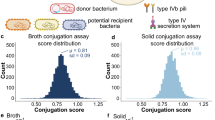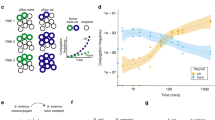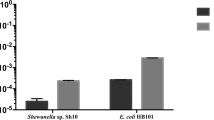Abstract
The IncC family of broad-host-range plasmids enables the spread of antibiotic resistance genes among human enteric pathogens1,2,3. Although aspects of IncC plasmid conjugation have been well studied4,5,6,7,8,9, many roles of conjugation genes have been assigned based solely on sequence similarity. We applied hypersaturated transposon mutagenesis and transposon-directed insertion-site sequencing to determine the set of genes required for IncC conjugation. We identified 27 conjugation genes, comprising 19 that were previously identified (including two regulatory genes, acaDC) and eight not previously associated with conjugation. We show that one previously unknown gene, acaB, encodes a transcriptional regulator that has a crucial role in the regulation of IncC conjugation. AcaB binds upstream of the acaDC promoter to increase acaDC transcription; in turn, AcaDC activates the transcription of IncC conjugation genes. We solved the crystal structure of AcaB at 2.9-Å resolution and used this to guide functional analyses that reveal how AcaB binds to DNA. This improved understanding of IncC conjugation provides a basis for the development of new approaches to reduce the spread of these multi-drug-resistance plasmids.
This is a preview of subscription content, access via your institution
Access options
Access Nature and 54 other Nature Portfolio journals
Get Nature+, our best-value online-access subscription
$29.99 / 30 days
cancel any time
Subscribe to this journal
Receive 12 digital issues and online access to articles
$119.00 per year
only $9.92 per issue
Buy this article
- Purchase on Springer Link
- Instant access to full article PDF
Prices may be subject to local taxes which are calculated during checkout




Similar content being viewed by others
Data availability
TraDIS read data have been deposited in the Sequence Read Archive: pre-conjugation-1 (SRR3990757), pre-conjugation-2 (SRR3990758), post-conjugation-1 (SRR8271039) and post-conjugation-2 (SRR8271040). The complete sequence of plasmid pMS6198A is available from Genbank (accession no. CP015835.1). Genbank accession numbers for other IncC plasmids are as follows: pSTY1-2010K-1587 (CP016864.1), pKAZ5 (KR827394.1) and pVCR94deltaX (KF551948.1). Sanger sequencing data confirming the identity of all plasmid constructs are available from the authors upon reasonable request. The structures have been deposited in the Protein Data Bank (PDB ID 6N8B for native AcaB and PDB ID 6N8A for the SeMet-containing protein). Source data are provided with this paper.
References
Harmer, C. J. & Hall, R. M. The A to Z of A/C plasmids. Plasmid 80, 63–82 (2015).
Hazen, T. H. et al. Comparative genomics of an IncA/C multidrug resistance plasmid from Escherichia coli and Klebsiella isolates from intensive care unit patients and the utility of whole-genome sequencing in health care settings. Antimicrob. Agents Chemother. 58, 4814–4825 (2014).
Doublet, B. et al. Complete nucleotide sequence of the multidrug resistance IncA/C plasmid pR55 from Klebsiella pneumoniae isolated in 1969. J. Antimicrob. Chemother. 67, 2354–2360 (2012).
Hegyi, A., Szabo, M., Olasz, F. & Kiss, J. Identification of oriT and a recombination hot spot in the IncA/C plasmid backbone. Sci. Rep. 7, 10595 (2017).
Lang, K. S. & Johnson, T. J. Characterization of Acr2, an H-NS-like protein encoded on A/C2-type plasmids. Plasmid 87–88, 17–27 (2016).
Carraro, N. et al. Development of pVCR94DeltaX from Vibrio cholerae, a prototype for studying multidrug resistant IncA/C conjugative plasmids. Front. Microbiol. 5, 44 (2014).
Carraro, N., Matteau, D., Luo, P., Rodrigue, S. & Burrus, V. The master activator of IncA/C conjugative plasmids stimulates genomic islands and multidrug resistance dissemination. PLoS Genet. 10, e1004714 (2014).
Carraro, N. et al. Salmonella genomic island 1 (SGI1) reshapes the mating apparatus of IncC conjugative plasmids to promote self-propagation. PLoS Genet. 13, e1006705 (2017).
Humbert, M., Huguet, K. T., Coulombe, F. & Burrus, V. Entry exclusion of conjugative plasmids of the IncA, IncC, and related untyped incompatibility groups. J. Bacteriol. 201, e00731-18 (2019).
Hancock, S. J. et al. Identification of IncA/C plasmid replication and maintenance genes and development of a plasmid multi-locus sequence-typing scheme. Antimicrob. Agents Chemother. 61, e01740-16 (2017).
Frost, L. S. & Koraimann, G. Regulation of bacterial conjugation: balancing opportunity with adversity. Future Microbiol. 5, 1057–1071 (2010).
Dong, A. et al. In situ proteolysis for protein crystallization and structure determination. Nat. Methods 4, 1019–1021 (2007).
Peng, Y. et al. Mechanistic basis of plasmid-specific DNA binding of the F plasmid regulatory protein, TraM. J. Mol. Biol. 426, 3783–3795 (2014).
Lu, J., den Dulk-Ras, A., Hooykaas, P. J. J. & Glover, J. N. M. Agrobacterium tumefaciens VirC2 enhances T-DNA transfer and virulence through its C-terminal ribbon-helix-helix DNA-binding fold. Proc. Natl Acad. Sci. USA 106, 9643–9648 (2009).
Rafferty, J. B., Somers, W. S., Saint-Girons, I. & Phillips, S. E. Three-dimensional crystal structures of Escherichia coli met repressor with and without corepressor. Nature 341, 705–710 (1989).
Raumann, B. E., Rould, M. A., Pabo, C. O. & Sauer, R. T. DNA recognition by beta-sheets in the Arc repressor-operator crystal structure. Nature 367, 754–757 (1994).
Weihofen, W. A., Cicek, A., Pratto, F., Alonso, J. C. & Saenger, W. Structures of omega repressors bound to direct and inverted DNA repeats explain modulation of transcription. Nucleic Acids Res. 34, 1450–1458 (2006).
Schreiter, E. R. & Drennan, C. L. Ribbon-helix-helix transcription factors: variations on a theme. Nat. Rev. Microbiol. 5, 710–720 (2007).
Jacoby, G. A. & Han, P. Detection of extended-spectrum beta-lactamases in clinical isolates of Klebsiella pneumoniae and Escherichia coli. J. Clin. Microbiol. 34, 908–911 (1996).
Carattoli, A. et al. Identification of plasmids by PCR-based replicon typing. J. Microbiol. Methods 63, 219–228 (2005).
Villa, L., Garcia-Fernandez, A., Fortini, D. & Carattoli, A. Replicon sequence typing of IncF plasmids carrying virulence and resistance determinants. J. Antimicrob. Chemother. 65, 2518–2529 (2010).
Langridge, G. C. et al. Simultaneous assay of every Salmonella typhi gene using one million transposon mutants. Genome Res. 19, 2308–2316 (2009).
Kakkanat, A. et al. The role of H4 flagella in Escherichia coli ST131 virulence. Sci. Rep. 5, 16149 (2015).
Robinson, M. D., McCarthy, D. J. & Smyth, G. K. edgeR: a Bioconductor package for differential expression analysis of digital gene expression data. Bioinformatics 26, 139–140 (2010).
Tamura, K., Stecher, G., Peterson, D., Filipski, A. & Kumar, S. MEGA6: Molecular Evolutionary Genetics Analysis version 6.0. Mol. Biol. Evol. 30, 2725–2729 (2013).
Tan, L., Moriel, D. G., Totsika, M., Beatson, S. A. & Schembri, M. A. Differential regulation of the surface-exposed and secreted SslE lipoprotein in extraintestinal pathogenic Escherichia coli. PLoS ONE 11, e0162391 (2016).
Tan, L., Strong, E. J., Woods, K. & West, N. P. Homologous alignment cloning: a rapid, flexible and highly efficient general molecular cloning method. PeerJ. 6, e5146 (2018).
Eschenfeldt, W. H., Lucy, S., Millard, C. S., Joachimiak, A. & Mark, I. D. A family of LIC vectors for high-throughput cloning and purification of proteins. Methods Mol. Biol. 498, 105–115 (2009).
Studier, F. W. Protein production by auto-induction in high density shaking cultures. Protein Expr. Purif. 41, 207–234 (2005).
Hwang, J. S., Yang, J. & Pittard, A. J. Specific contacts between residues in the DNA-binding domain of the TyrR protein and bases in the operator of the tyrP gene of Escherichia coli. J. Bacteriol. 181, 2338–2345 (1999).
Jerabek-Willemsen, M. et al. MicroScale thermophoresis: interaction analysis and beyond. J. Mol. Struct. 1077, 101–113 (2014).
Ullah, M. O. et al. Crystallization and X-ray diffraction analysis of the N-terminal domain of the Toll-like receptor signalling adaptor protein TRIF/TICAM-1. Acta Cryst. F 69, 766–770 (2013).
Aragao, D. et al. MX2: a high-flux undulator microfocus beamline serving both the chemical and macromolecular crystallography communities at the Australian Synchrotron. J. Synchrotron Radiat. 25, 885–891 (2018).
Kabsch, W. XDS. Acta Cryst. D 66, 125–132 (2010).
Evans, P. R. & Murshudov, G. N. How good are my data and what is the resolution? Acta Cryst. D 69, 1204–1214 (2013).
Terwilliger, T. C. et al. Decision-making in structure solution using Bayesian estimates of map quality: the PHENIX AutoSol wizard. Acta Cryst. D 65, 582–601 (2009).
Terwilliger, T. C. et al. Iterative model building, structure refinement and density modification with the PHENIX AutoBuild wizard. Acta Cryst. D 64, 61–69 (2008).
McCoy, A. J. Solving structures of protein complexes by molecular replacement with Phaser. Acta Cryst. D 63, 32–41 (2007).
Afonine, P. V. et al. Towards automated crystallographic structure refinement with phenix.refine. Acta Cryst. D 68, 352–367 (2012).
Emsley, P., Lohkamp, B., Scott, W. G. & Cowtan, K. Features and development of Coot. Acta Cryst. D 66, 486–501 (2010).
Krissinel, E. & Henrick, K. Inference of macromolecular assemblies from crystalline state. J. Mol. Biol. 372, 774–797 (2007).
Thomas, C. M. et al. Annotation of plasmid genes. Plasmid 91, 61–67 (2017).
Jurrus, E. et al. Improvements to the APBS biomolecular solvation software suite. Protein Sci. 27, 112–128 (2018).
Acknowledgements
We acknowledge the scientific and technical assistance of the Australian Microscopy and Microanalysis Research Facility at the Centre for Microscopy and Microanalysis, The University of Queensland, the Institute for Molecular Bioscience Sequencing Facility and the Australian Synchrotron MX beamlines, part of ANSTO, and we made use of the Australian Cancer Research Foundation detector. This work was supported by Project (nos. GNT1106590, GNT1033799 and GNT1067455) and Program (no. GNT1071659) grants from the Australian National Health and Medical Research Council (NHMRC). S.J.H. is supported by an Australian Government Research Training Program Scholarship. M.A.S. is supported by an NHMRC Senior Research Fellowship (no. GNT1106930), S.A.B. is supported by a NHMRC Career Development Fellowship (no. GNT1090456) and B.K. is supported by a NHMRC Principal Research Fellowship (no. GNT1110971) and an Australian Research Council Laureate Fellowship (no. FL180100109). The funders had no role in study design, data collection and interpretation, or the decision to submit the work for publication.
Author information
Authors and Affiliations
Contributions
S.J.H. and Z.L. performed experiments, with assistance from M.-D.P., A.W.L., K.M.P., N.T.K.N., B.M.F., J.W. and J.Y. S.J.H., Z.L., M.-D.P., B.K. and M.A.S. designed the study. S.J.H., Z.L., M.-D.P., B.M.F., J.W., J.Y., R.A.S., S.A.B., B.K. and M.A.S. analysed the data. M.-D.P., R.A.S., D.L.P., T.R.W., B.K., S.A.B. and M.A.S. supervised aspects of the project and provided essential expert analysis. All authors contributed to the interpretation of the results. S.J.H., Z.L., M.-D.P., B.K. and M.A.S. wrote the manuscript. All authors read and approved the final manuscript.
Corresponding authors
Ethics declarations
Competing interests
The authors declare no competing interests.
Additional information
Publisher’s note Springer Nature remains neutral with regard to jurisdictional claims in published maps and institutional affiliations.
Extended data
Extended Data Fig. 1 Schematic representation of the pMS6198A backbone.
Rings from inside-out represent: GC-content, GC-skew, notable DNA elements (green, AcaDC binding site7; red, origin of replication (oriV); blue, origin of transfer (oriT)), coding sequences (CDS) on reverse strand, and CDS on forward strand. CDS are colour-coded by function; red, replication; yellow, stability; blue, conjugation; green, conjugation regulation. Blue brackets show defined conjugation regions.
Extended Data Fig. 2 AcaB is activated by AcaDC.
a, qRT-PCR targeting acaB, standardised to repA. b, pQF50-PacaB in the presence/absence of AcaDC. Individual values of biological replicates are shown as dot points with the grey bar indicating the mean. All strains were assayed in biological triplicates. Statistical tests were performed on log10-transformed values using (a) One-way ANOVA and Sidak’s multiple comparisons and (b) two-sided unpaired t-test comparisons.
Extended Data Fig. 3 Electrophoretic mobility shift assay with AcaB showing binding specificity for Pacr1-567.
Competitive (comp) DNA was amplified from other regions of pMS6198A (409bp: 7975..8383 and 685bp: 7907..8591), see Supplementary Table 4. Experiment was repeated three times with similar results. No molecular weight ladder is present. Full unprocessed image provided as Source Data Fig. 2.
Extended Data Fig. 4 DNaseI footprinting analysis of AcaB bound to Pacr1, targeting the region -689 to -412 bp relative to acr1 ATG.
End-labelled primers were used to map the protected region in the presence of increasing concentrations of AcaB. Nucleotide sequencing (GA ladder) was performed using the same primers. The protected region is indicated, along with the corresponding DNA sequence. The experiment was performed once.
Extended Data Fig. 5 Superimposition of the two β-α-α units in AcaB.
Yellow: residues 23-97; cyan: residues 109-183. Residues are superimposed using Cα atoms.
Extended Data Fig. 6 Comparison of the AcaB structure to characterised RHH proteins.
The β-sheet region responsible for DNA-binding is shown in red.
Extended Data Fig. 7 Analyses of AcaB oligomerisation in solution.
a, SEC-MALS. Red and blue curves indicate the normalised UV traces of the WT protein and the E69A mutant, respectively. The dotted lines under the peaks are calculated average molecular mass using the same colour scheme. b, Glutaraldehyde and SDS-PAGE. Lane 1: AcaB with 0 % (v/v) glutaraldehyde; Lane 2: AcaB with 0.005 % (v/v) glutaraldehyde; Lane 3: AcaBE69A with 0 % (v/v) glutaraldehyde; Lane 4: AcaBE69A with 0.005 % (v/v) glutaraldehyde. Each experiment was repeated three times with similar results.
Supplementary information
Supplementary Information
Supplementary Figs. 1–3 and Tables 1–5.
Source data
Source Data Fig. 1
Unprocessed immunolot.
Source Data Fig. 2
Unprocessed EMSA.
Rights and permissions
About this article
Cite this article
Hancock, S.J., Phan, MD., Luo, Z. et al. Comprehensive analysis of IncC plasmid conjugation identifies a crucial role for the transcriptional regulator AcaB. Nat Microbiol 5, 1340–1348 (2020). https://doi.org/10.1038/s41564-020-0775-0
Received:
Accepted:
Published:
Issue Date:
DOI: https://doi.org/10.1038/s41564-020-0775-0



